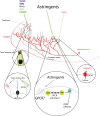Astringency: a more stringent definition
- PMID: 24860069
- PMCID: PMC4064959
- DOI: 10.1093/chemse/bju021
Astringency: a more stringent definition
Abstract
Despite being an everyday sensory experience, the nature of astringency perception is not clear. In this issue of Chemical Senses, Schöbel et al. demonstrate that astringency is a trigeminal sensation in human, and astringents trigger a G protein-coupled pathway in trigeminal ganglion cells in the mouse.
Keywords: G protein; astringency; taste; trigeminal sensation.
© The Author 2014. Published by Oxford University Press. All rights reserved. For permissions, please e-mail: journals.permissions@oup.com.
Figures


Similar articles
-
Astringency is a trigeminal sensation that involves the activation of G protein-coupled signaling by phenolic compounds.Chem Senses. 2014 Jul;39(6):471-87. doi: 10.1093/chemse/bju014. Epub 2014 Apr 9. Chem Senses. 2014. PMID: 24718416
-
Perspectives on Astringency Sensation: An Alternative Hypothesis on the Molecular Origin of Astringency.J Agric Food Chem. 2021 Apr 7;69(13):3822-3826. doi: 10.1021/acs.jafc.0c07474. Epub 2021 Mar 8. J Agric Food Chem. 2021. PMID: 33682421
-
Effect of Astringent Stimuli on Salivary Protein Interactions Elucidated by Complementary Proteomics Approaches.J Agric Food Chem. 2017 Mar 15;65(10):2147-2154. doi: 10.1021/acs.jafc.7b00436. Epub 2017 Mar 6. J Agric Food Chem. 2017. PMID: 28225606
-
Oral astringency: a tactile component of flavor.Acta Psychol (Amst). 1993 Oct;84(1):119-25. doi: 10.1016/0001-6918(93)90078-6. Acta Psychol (Amst). 1993. PMID: 8237452 Review.
-
Interactions between wine phenolic compounds and human saliva in astringency perception.Food Funct. 2018 Mar 1;9(3):1294-1309. doi: 10.1039/c7fo02030a. Epub 2018 Feb 8. Food Funct. 2018. PMID: 29417111 Review.
Cited by
-
Astringency sensitivity to tannic acid: Effect of ageing and salivary proline-rich protein levels.Food Chem (Oxf). 2023 Dec 28;8:100192. doi: 10.1016/j.fochms.2023.100192. eCollection 2024 Jul 30. Food Chem (Oxf). 2023. PMID: 38234464 Free PMC article.
-
Oat-based milk alternatives: the influence of physical and chemical properties on the sensory profile.Front Nutr. 2024 Feb 5;11:1345371. doi: 10.3389/fnut.2024.1345371. eCollection 2024. Front Nutr. 2024. PMID: 38379545 Free PMC article.
-
Cognitive Keys in Psychophysical Estimation of Chemosensory Perception in University Students.Foods. 2021 Dec 17;10(12):3134. doi: 10.3390/foods10123134. Foods. 2021. PMID: 34945685 Free PMC article.
-
Extraoral Taste Receptor Discovery: New Light on Ayurvedic Pharmacology.Evid Based Complement Alternat Med. 2017;2017:5435831. doi: 10.1155/2017/5435831. Epub 2017 May 31. Evid Based Complement Alternat Med. 2017. PMID: 28642799 Free PMC article. Review.
-
Exploring Olfactory-Oral Cross-Modal Interactions through Sensory and Chemical Characteristics of Italian Red Wines.Foods. 2020 Oct 24;9(11):1530. doi: 10.3390/foods9111530. Foods. 2020. PMID: 33114385 Free PMC article.
References
-
- Baxter NJ, Lilley TH, Haslam E, Williamson MP. 1997. Multiple interactions between polyphenols and a salivary proline-rich protein repeat result in complexation and precipitation. Biochemistry. 36(18):5566–5577 - PubMed
-
- Chandrashekar J, Mueller KL, Hoon MA, Adler E, Feng L, Guo W, Zuker CS, Ryba NJ. 2000. T2Rs function as bitter taste receptors. Cell. 100(6):703–711 - PubMed
-
- Green BG. 1993. Oral astringency: a tactile component of flavor. Acta Psychol (Amst). 84(1):119–125 - PubMed
-
- Lee CA, Ismail B, Vickers ZM. 2012. The role of salivary proteins in the mechanism of astringency. J Food Sci. 77(4):C381–C387 - PubMed
Publication types
MeSH terms
Substances
Grants and funding
LinkOut - more resources
Full Text Sources
Other Literature Sources

